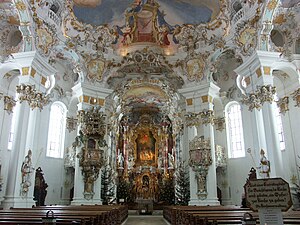
Rococo, less commonly Roccoco or Late Baroque, is an exceptionally ornamental and theatrical style of architecture, art and decoration which combines asymmetry, scrolling curves, gilding, white and pastel colours, sculpted moulding, and trompe-l'œil frescoes to create surprise and the illusion of motion and drama. It is often described as the final expression of the Baroque movement.

The Pilgrimage Church of Wies is an oval Rococo church, designed in the late 1740s by brothers J. B. and Dominikus Zimmermann, the latter of whom lived nearby for the last eleven years of his life. It is located in the foothills of the Alps, in the municipality of Steingaden in the Weilheim-Schongau district, Bavaria, Germany. Because of its outstanding rococo architecture, the Wieskirche was added to the UNESCO World Heritage List in 1983.
Dominikus Zimmermann was a German Rococo architect and stuccoist.

Ettal Abbey is a Benedictine monastery in the village of Ettal close to Oberammergau and Garmisch-Partenkirchen in Bavaria, Germany. With a community of more than 50 monks, with another five at Wechselburg, the Abbey is one of the largest Benedictine houses and is a major attraction for visitors.

Rocaille was a French style of exuberant decoration, with an abundance of curves, counter-curves, undulations and elements modeled on nature, that appeared in furniture and interior decoration during the early reign of Louis XV of France. It was a reaction against the heaviness and formality of the Louis XIV style. It began in about 1710, reached its peak in the 1730s, and came to an end in the late 1750s, replaced by Neoclassicism. It was the beginning of the French Baroque movement in furniture and design, and also marked the beginning of the Rococo movement, which spread to Italy, Bavaria and Austria by the mid-18th century.
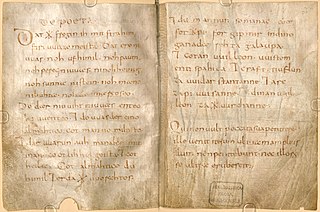
The Wessobrunn Prayer is among the earliest known poetic works in Old High German, believed to date from the end of the 8th century.

Amorbach Abbey was a Benedictine imperial abbey of the Holy Roman Empire located at Amorbach. It was later the residence of the rulers of the short-lived Principality of Leiningen, before that became part of the Kingdom of Bavaria, and its historic buildings still belong to the princely family.

Wessobrunn Abbey was a Benedictine monastery near Weilheim in Bavaria, Germany.
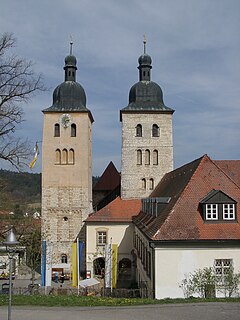
Plankstetten Abbey is a monastery of the Benedictines located between Berching and Beilngries in Bavaria, Germany. It is a member of the Bavarian Congregation of the Benedictine Confederation.

Schäftlarn Abbey is a Benedictine monastery on the Isar in Schäftlarn, south of Munich in Bavaria, Germany.
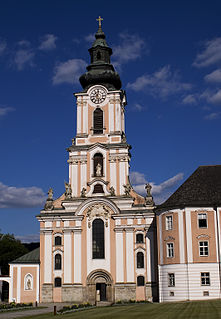
Wilhering Abbey is a Cistercian monastery in Wilhering in Upper Austria, about 8 km (5 mi) from Linz. The buildings, re-constructed in the 18th century, are known for their spectacular Rococo decoration.
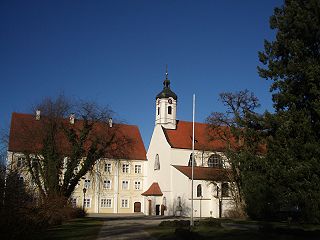
Gutenzell Abbey was a Cistercian nunnery in the municipality of Gutenzell-Hürbel in the district of Biberach, Baden-Württemberg, Germany.
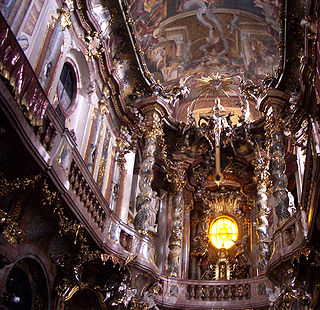
The Asam brothers were sculptors, workers in stucco, painters, and architects, who worked mostly together and in southern Germany. They are among the most important representatives of the German late Baroque.

Johann Michael Feuchtmayer was a German stuccoworker and sculptor of the late Baroque period. He collaborated with the architects Johann Michael Fischer, Johann Joseph Christian, and Franz Joseph Spiegler on numerous ecclesiastical buildings in Upper Swabia. His stucco decoration in the Benedictine abbey church of Ottobeuren is considered his crowning achievement.

Matthäus Günther was an important German painter and artist of the Baroque and Rococo era.

Franz Xaver Feuchtmayer (1698–1763) was a German Baroque stucco plasterer of the Wessobrunner School.

Joseph Anton Feuchtmayer was an important Rococo stuccoist and sculptor, active in southern Germany and Switzerland.

Johann Baptist Zimmermann was a German painter and a prime stucco plasterer during the Baroque.
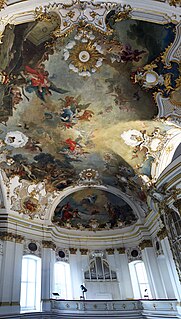
Livio Retti was an Italian Baroque painter who worked mainly in present-day South Germany, at the time the Duchy of Württemberg, the Duchy of Bavaria, some secular or ecclesiastical franconians principalities and some free imperial cities such as Schwäbisch Hall for example.
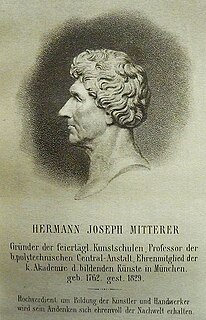
Hermann Joseph Mitterer, was a German drawing teacher, founder of Munich's Feiertägliche Zeichnungsschule in 1792 and co-founder of Feiertagsschule München in 1793, forerunners of later vocational schools. On Mitterer's initiative, drawing lessons were made compulsory in all schools in Bavaria as early as 1789. He also founded the first Lithographische Kunstanstalt.
